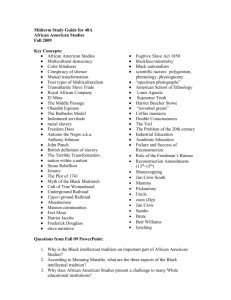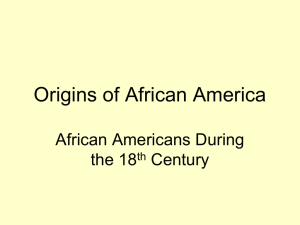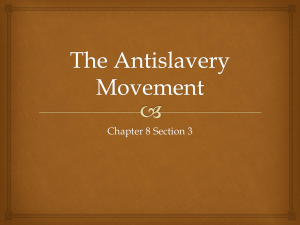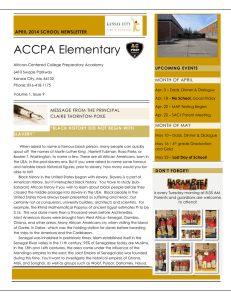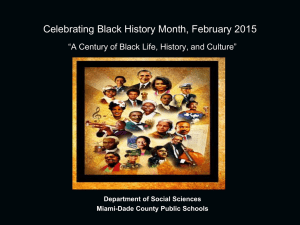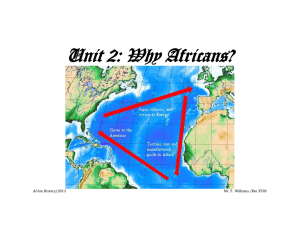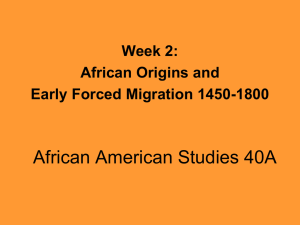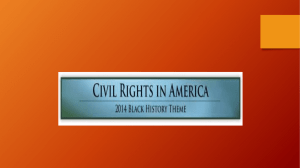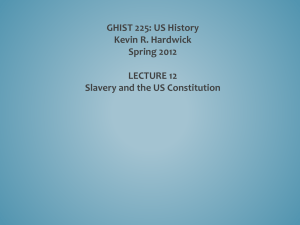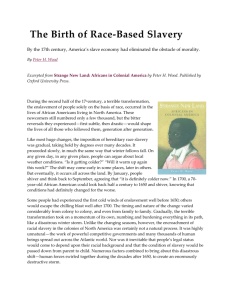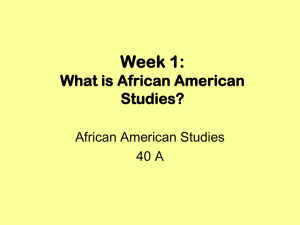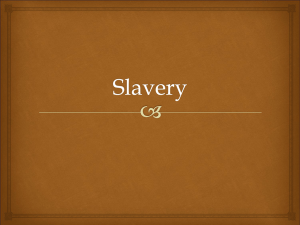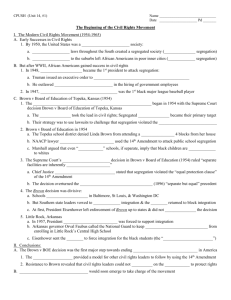African American History
advertisement
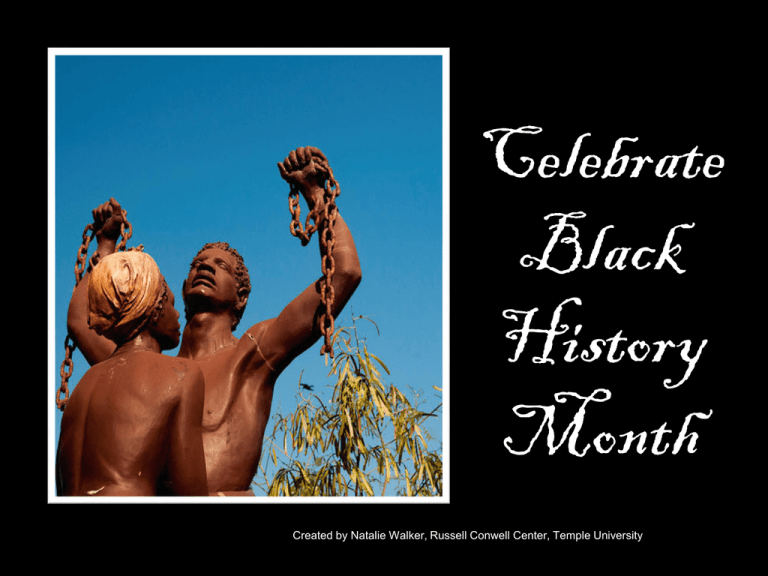
Celebrate Black History Month Created by Natalie Walker, Russell Conwell Center, Temple University Welcome! Thank you for “attending” the African American History Month Online Workshop. There is a lot of great information about various aspects of African American history and culture . Please familiarize yourself with the information provided on this PowerPoint, the information given through the video and be prepared to take the quiz afterward. February is… Black History Month In 1915, Dr. Carter G. Woodson and Rev. Jesse E. Moorland co-founded the Association for the Study of Negro Life and History (ASNLH). Their goal was to research and bring awareness to the largely ignored, yet crucial role black people played in American and world history. He also felt the importance of preserving one’s heritage and, upon his urgings, the fraternity Omega Psi Phi created Negro History and Literature Week in 1920. In 1926, Woodson changed the name to Negro History Week. He selected the month of February for the celebration as a way to honor of the birth of two men whose actions drastically altered the future of black Americans. Abraham Lincoln, the U.S. President who issued the Emancipation Proclamation was born on February 12th and Frederick Douglass, one of the nation’s leading abolitionists was born on February 14th. Dr. Carter G. Woodson died in 1950, but his legacy continued on as the celebration of Negro History Week was adopted by cities and organizations across the country. This observance proved especially important during the Civil Rights Movement of the 1950s and 1960s, a time when the inhumane and unequal treatment of black people in America was being challenged and overturned. The Black Power Movement of the 1970s emphasized racial pride and the significance of collective cultural values. This prompted the ASNLH, now called the Association for the Study of African American Life and History, to change Negro History Week to Black History Week. In 1976, they extended the week to a month-long observance. Black History Month is now recognized and widely celebrated by the entire nation on both a scholarly and commercial level. The Association for the Study of African American Life and History continues to promote, preserve and research black history and culture year-round. In 1619… The first Africans as slave labor are introduced in America. A Dutch trader exchanges his cargo of 20 Africans for food in Jamestown Virginia, in August of 1619. It is believed that these Africans were sold into conditions similar to indentured servitude - a common practice in England and colonial America. The American slavery system became more developed and codified in its inhumane treatment around 1680. From 1619 to about 1640, Africans could earn their freedom working as laborers and artisans for the European settlers. Africans could become free people and enjoy some of the liberties like other new settlers. By 1640, Maryland became the first colony to institutionalize slavery. In 1641, Massachusetts, in its written legislative Body of Liberties, stated that "bondage was legal" servitude, at that moment changing the conditions of the African workers - they became chattel slaves who could be bought and solely owned by their masters. In 1808… The US bans the import of slaves, but not the sale and practice of slavery. In 1846… • Frederick Douglass (1818-1895) launches an abolitionist newspaper The North Star. Douglass escaped from slavery in 1838 by posing as a free black seaman on a train ride to the north and became an infamous speaker on the abolitionist lecture circuit and an important political figure. He served as president of the Freedman's Savings Bank during Reconstruction and penned his autobiography "Narrative of the Life of Frederick Douglass" in 1845. In 1850… • The Underground Railroad is started by William Still. It is a network of secret routes, way-stations, safe havens and meeting points in which thousands of African-Americans will escape from slavery in the south. Some routes on the Underground Railroad traveled as far north as Canada and as far south as Mexico. • Harriet Tubman (1820 - 1913), born Araminta Ross escapes from slavery and becomes one of the most celebrated and effective leaders of the Underground Railroad. Harriet Tubman will guide hundreds of slaves to freedom before and during the war. She was never captured while rescuing slaves and as she was quoted she "never lost a passenger". 1861-1865 • The Civil War begins in1861 when South Carolina, Mississippi, Florida, Alabama, Georgia, Louisiana, and Texas secede from the Union and form the Confederate States of America with Jefferson Davis as their president. Later in the year Arkansas, Tennessee, North Carolina and Virginia join them. Virginia was divided up - with the eastern portion seceding to the Confederacy and West Virginia remaining with the Union. It is the bloodiest war in American history, being fought entirely on American soil and resulting in the death of about 600,000. • Abraham Lincoln issues the Emancipation Proclamation, a presidential order declaring the freedom of the slaves and makes the end of slavery a major goal of the Civil War. • In 1865 the Civil War ends and the 13th Amendment to the Constitution abolishes slavery. 1866-1875 • 1866: the Civil Rights Act sought to protect freedmen and grant full citizenship to those born on U.S. soil, except Indians. • 1868: the 14th Amendment to the Constitution grants citizenship to former slaves. • 1870: the 15th Amendment to the Constitution prohibits states from denying the right to vote because of race. In 1909… • The National Association for the Advancement of Colored People, NAACP, is founded by W.E.B Dubois, Ida B. Wells-Barnett, Henry Moscowitz , Mary White Ovington, Oswald Garrison Villard, and William English Walling as an interracial organization "to promote equality of rights and to eradicate caste or race prejudice among the citizens of the United States; to advance the interest of colored citizens; to secure for them impartial suffrage; and to increase their opportunities for securing justice in the courts, education for the children, employment according to their ability and complete equality before law." The Civil Rights Movement • The African-American Civil Rights Movement (1955–1968) refers to the reform movements in the United States aimed at outlawing racial discrimination against African Americans and restoring Suffrage in Southern states. By 1966, the emergence of the Black Power Movement, which lasted roughly from 1966 to 1975, enlarged the aims of the Civil Rights Movement to include racial dignity, economic and political self-sufficiency, and freedom from oppression by whites. • Many of those who were active in the Civil Rights Movement, with organizations such as NAACP, SNCC, CORE and SCLC, prefer the term "Southern Freedom Movement" because the struggle was about far more than just civil rights under law; it was also about fundamental issues of freedom, respect, dignity, and economic and social equality. The Civil Rights Movement During the period 1955–1968, acts of nonviolent protest and civil disobedience produced crisis situations between activists and government authorities. Federal, state, and local governments, businesses, educational institutions, and communities often had to respond immediately to crisis situations which highlighted the inequities faced by African Americans. Forms of protest and/or civil disobedience included boycotts such as the successful Montgomery Bus Boycott (1955–1956) in Alabama; "sit-ins" such as the influential Greensboro sit-in (1960) in North Carolina; marches, such as the Selma to Montgomery marches (1965) in Alabama; and a wide range of other nonviolent activities. Black Power Movement The Black Power movement grew out of the CIVIL RIGHTS MOVEMENT that had steadily gained momentum through the 1950s and 1960s. Although not a formal movement, the Black Power movement marked a turning point in black-white relations in the United States and also in how blacks saw themselves. The movement was hailed by some as a positive and proactive force aimed at helping blacks achieve full equality with whites, but it was reviled by others as a militant, sometimes violent faction whose primary goal was to drive a wedge between whites and blacks. In truth, the Black Power movement was a complex event that took place at a time when society and culture was being transformed throughout the United States, and its legacy reflects that complexity. Million Man March The Million Man March, organized by Louis Farrakhan in 1995, brought together thousands of AfricanAmericans to the National Mall in Washington, D.C. for a day of unity and a show of strength of character. Despite the name, women are present both in the crowd and on the podium, including civil rights pioneer Rosa Parks. The Oscars Halle Berry and Denzel Washington win Academy Awards for best actress in "Monster's Ball" and best actor in "Training Day" respectively. Watch Halle’s Acceptance Speech In 2008… • In June, Senator Barack Obama becomes the first African-American to win the Democratic nomination for U.S. presidential candidate. Obama wins the presidential election on November 4th, becoming the first AfricanAmerican president-elect. Keep in mind… • This workshop only outlines a brief history of African American experience and history. From music to film to literature to politics, the contributions that African Americans have made in the United States have helped shape the country into what it is today. African American history is all of our history. Thanks for attending! You’re almost done… Please complete the quiz in its entirety to receive credit for attendance. The survey/quiz can be found here or copy and paste this link into your browser. http://www.surveymonkey.com/s/CTF7GXM


